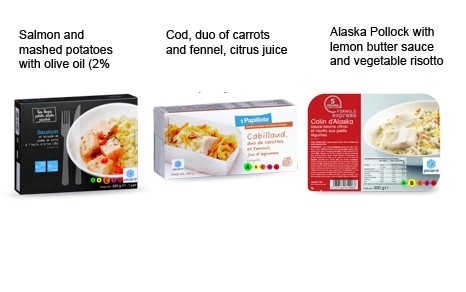While the French High Council for Public Health (HCSP) made public on Monday, 24 August 2015, a positive opinion regarding the relevance of the 5-colour code for the public, a team of researchers (Inserm/INRA/Paris 13 University) directed by Serge Hercberg, on publication of their article in the journal Nutrients, demonstrated that the 5-colour nutrition label (5-CNL) is the most effective nutritional information system for allowing consumers to recognise and compare the nutritional quality of foods, including “at-risk” populations (older subjects, those with a lower educational level, lower income, lower nutritional knowledge, and overweight or obese individuals)
Article 5 of the Health Act, introduced by Marisol Touraine, Minister of Health, and passed by the French Parliament, states, “…to make it easier to inform consumers and to help the consumer make informed choices, that the mandatory nutrition declaration may be accompanied by a presentation or complementary expression using graphics or symbols on the front of packaging.”
Several systems have been proposed at national and international level. In France, many learned societies support the establishment of the 5-CNL 5-colour nutritional labelling system (green/yellow/orange/fuchsia pink/red). The latter is based on the calculation of a nutritional quality score (nutrient profiling system, Food Standards Agency, FSA), which takes several elements present on the nutrition label into account (calories, simple sugars, saturated fatty acids, sodium, fibre, protein and percentage of fruits and vegetables per 100 g of product), to arrive at a unique indicator of the nutritional quality of the food.
Several studies have already contributed to the validation of the FSA score, by showing that the nutritional quality of foods consumed evaluated by the FSA score is linked to the overall quality of the diet and nutritional status of individuals, and in a prospective manner to the risk of disease. These scientific studies underscore the interest of putting the 5-colour nutrition label (5-CNL), based on FSA score, on the front of food packaging in order to better guide consumers in their food choices. This system is the subject of considerable controversy, fuelled among others by the various industrial stakeholders, who cast doubt on its value.
The study published today by EREN under the direction of Pauline Ducrot (PhD student in Nutrition) and Sandrine Péneau (Lecturer in Nutrition, Paris 13 University) in the journal Nutrients compares the effect of different nutrition labels on the front of packs of various foods on the ability of consumers to rank foods appropriately. The study was carried out on a sample of 14,230 adults participating in the NutriNet-Santé study. The impact of 4 simplified nutritional labelling systems was tested: the colour-based 5-CNL system; the Green Tick, similar to that used in some Scandinavian countries and the Netherlands; the Multiple Traffic Light system used in Great Britain, and the Guideline Daily Amounts (or Reference Intakes) system already used in France by some industrial companies. A logo-free situation was also used as a reference.
With the help of a Web-based questionnaire specifically developed for this study, participants in the study were asked to rank, on a relative basis (“less good,” “moderate,” “the best” or “I don’t know”) the nutritional quality of different series of 3 foods belonging to the same category.
Five categories of foods were tested: frozen fish products, pizzas, dairy products, breakfast mueslis and appetisers.

Example (5-CNL on fish-based frozen products):
Each participant had to randomly test a combination of food products and nutrition labels from the 5 categories. For this, 25 different versions of the questionnaire were used. A statistical design (Latin Square) made it possible to ensure an equal number of participants for each labelling/product category combination.
The results of this specific study on the comprehension of nutritional logos show that:- Generally speaking, individuals “at risk” of having a nutritionally poorer quality diet (older subjects, participants with a lower educational level, lower income, lower nutritional knowledge, and overweight or obese individuals) had greater difficulty in ranking food products according to their nutritional quality.
- The various nutrition labels significantly increased the ability of individuals, including those at risk, to rank 3 foods in order of their nutritional quality, compared with a logo-free setting.
- The nutrition labels had more impact than individual characteristics (education level, income, etc.) on increasing the ability of the individuals to correctly rank the foods by nutritional quality. The chance of correctly ranking the products was multiplied up to 12-fold with a logo, whereas individual characteristics enabled an increase in the chance by a factor of only 1.17.
- Of the nutrition labels tested, the 5-colour nutritional labelling system (5-CNL) was the most effective in terms of comprehension. It performed better than the Traffic Light, Reference Intakes, or Green Tick labelling systems.
- The 5-CNL system performed better, including among individuals with a relatively “unfavourable” diet in terms of nutrition and health. In particular, the presence of 5-CNL strongly increased (over twenty-fold compared to the logo-free situation) the ability of individuals with no knowledge of nutrition to correctly rank the products compared with a logo-free situation.
The results of this study emphasise the interest of nutrition labels for helping consumers, particularly those at risk of making food choices that are relatively “unfavourable” to their health, to identify the products most conducive to a balanced diet.
The 5-colour logo (5-CNL) system turns out to be the best understood among individuals as a whole, and may therefore make it possible to inform consumers effectively and equitably on the nutritional quality of products, and thereby incorporate this information into determinants of their food choices.
These contents could be interesting :


